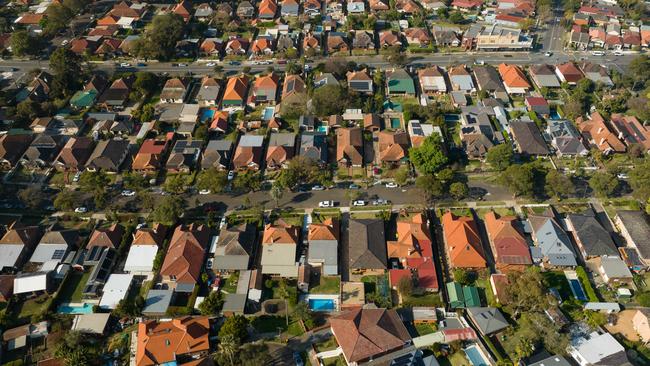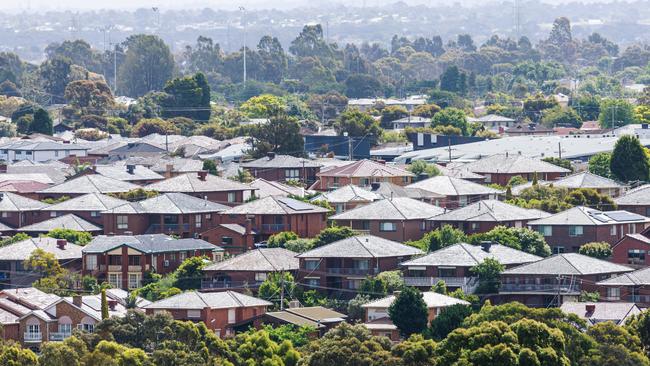Mortgage-belt homeowners unknowingly prisoners to their loans as fixed rates expire
Thousands of homeowners with fixed loans about to expire are unknowingly mortgage prisoners, with no way of refinancing after 4 per cent of rate rises in the past 18 months.

Thousands of homeowners in the mortgage belts of Australia’s capital cities are unknowingly loan prisoners as the ultra-low interest rates they secured during the pandemic expire with little hope of getting a better deal.
Three in four of the 880,000 mortgages fixed to interest rates secured on rates as low as 2 per cent will have reverted to current rates of more than 6 per cent by the end of the month, after the nation has experienced the fastest interest rate hiking cycle in a generation.
For those still waiting to tick over this year at what increasingly appears to be the height of rates, data compiled exclusively by Lendi for The Weekend Australian suggests homeowners in outer-city suburbia are those most at risk of mortgage pain.
Lendi chief operating officer Sebastian Watkins said many of these people were unknowingly unable to refinance to a better rate because they would no longer meet serviceability requirements for their loans, leaving them “mortgage prisoners”.

“NSW and states with large loan sizes will be the ones to watch around financial stress and pressure … and there’ll be a lot of customers (who) won’t be able to do much about it,” Mr Watkins said.
While some banks have dropped the “buffer” of serviceability checks from the standard 3 per cent to 1 per cent for refinancers, Mr Watkins said he believed many would still struggle to prove on paper that they could make their repayments.
“If your income is looking largely the same as it was two or three years ago, there’s a lot (who) are going to be trapped in that existing mortgage because new banks won’t be able to demonstrate their serviceability at 9 per cent,” he said.
Of the loans remaining to expire this year, almost one-third are in NSW, with the average loan there now requiring an additional injection of $1708 a month.
The mortgage brokerage has identified western Sydney postcodes 2145 and 2747, which include the suburbs of Greystanes, Westmead and new masterplan communities Jordan Springs and Caddens, as those most at risk from rate rises.
Around one in five loans will expire in each of the remaining east coast states by year’s end.
In Melbourne, outer city postcodes such as Craigieburn’s 3064 in the north and 3977 out east encompassing Cranbourne are where the most homeowners are at risk as they are forced to look for an extra $1421 in repayments.

Meanwhile, pain in Queensland equates to $1237 more each month, and is being felt most acutely in Ipswich’s Springfield and Goodna (4300) and the Gold Coast’s 4209 area of Upper Coomera and Pimpama.
Brisbane-based mortgage broker Mick O’Shea said his phone kept ringing with people asking “Am I going to lose my home?”
People who are most concerned are those who have had a change of circumstances – maybe they’ve had another child or taken a new job at a lower pay, or are now without bonuses and penalty rates.
Others are simply close to “breads and spreads”.
“Rates have gone up 4 per cent, alongside the rising cost of living,” Mr O’Shea said.
“These people aren’t the ones driving inflation, that’s for sure.”

Lendi’s own arrears figures show payments 90-days past due are at 0.7 per cent of the market, almost double the long-term average of 0.4 per cent.
Mr Watkins said even though that was “really healthy” by industry standards, it still painted a troubling picture.
“I suspect that’s coming from people (who) rolled off fixed rates earlier in the year,” he said.
“I think we’re going to see a massive amplification of that trend over the next four months.”
Not everyone is convinced the prophesied “mortgage cliff” will eventuate.
SQM Research managing director Louis Christopher said “distressed listings” figures had declined over the past 12 months, which suggested people weren’t in completely dire straits.
He said he believed it was a combination of banks being more flexible, stronger loan checks at application and low employment.
“We’re a little bit more confident that the fears have been a little bit overblown,” Mr Christopher said. “Now if we were to see a harder lending economy, and we were to see a rise in unemployment next year to about 5 per cent, that’s when I think we would see a lot more distress activity on the ground.”








To join the conversation, please log in. Don't have an account? Register
Join the conversation, you are commenting as Logout